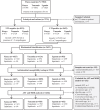Predominance of multidrug-resistant bacteria causing urinary tract infections among symptomatic patients in East Africa: a call for action
- PMID: 38372000
- PMCID: PMC10873138
- DOI: 10.1093/jacamr/dlae019
Predominance of multidrug-resistant bacteria causing urinary tract infections among symptomatic patients in East Africa: a call for action
Abstract
Background: In low- and middle-income countries, antibiotics are often prescribed for patients with symptoms of urinary tract infections (UTIs) without microbiological confirmation. Inappropriate antibiotic use can contribute to antimicrobial resistance (AMR) and the selection of MDR bacteria. Data on antibiotic susceptibility of cultured bacteria are important in drafting empirical treatment guidelines and monitoring resistance trends, which can prevent the spread of AMR. In East Africa, antibiotic susceptibility data are sparse. To fill the gap, this study reports common microorganisms and their susceptibility patterns isolated from patients with UTI-like symptoms in Kenya, Tanzania and Uganda. Within each country, patients were recruited from three sites that were sociodemographically distinct and representative of different populations.
Methods: UTI was defined by the presence of >104 cfu/mL of one or two uropathogens in mid-stream urine samples. Identification of microorganisms was done using biochemical methods. Antimicrobial susceptibility testing was performed by the Kirby-Bauer disc diffusion assay. MDR bacteria were defined as isolates resistant to at least one agent in three or more classes of antimicrobial agents.
Results: Microbiologically confirmed UTI was observed in 2653 (35.0%) of the 7583 patients studied. The predominant bacteria were Escherichia coli (37.0%), Staphylococcus spp. (26.3%), Klebsiella spp. (5.8%) and Enterococcus spp. (5.5%). E. coli contributed 982 of the isolates, with an MDR proportion of 52.2%. Staphylococcus spp. contributed 697 of the isolates, with an MDR rate of 60.3%. The overall proportion of MDR bacteria (n = 1153) was 50.9%.
Conclusions: MDR bacteria are common causes of UTI in patients attending healthcare centres in East African countries, which emphasizes the need for investment in laboratory culture capacity and diagnostic algorithms to improve accuracy of diagnosis that will lead to appropriate antibiotic use to prevent and control AMR.
© The Author(s) 2024. Published by Oxford University Press on behalf of British Society for Antimicrobial Chemotherapy.
Figures
References
-
- WHO 2021. Antimicrobial resistance. https://www.who.int/news-room/fact-sheets/detail/antimicrobial-resistance.
-
- Asiimwe BB, Kiiru J, Mshana SE et al. Protocol for an interdisciplinary cross-sectional study investigating the social, biological and community-level drivers of antimicrobial resistance (AMR): holistic approach to unravel antibacterial resistance in East Africa (HATUA). BMJ Open 2021; 11: e041418. 10.1136/bmjopen-2020-041418 - DOI - PMC - PubMed
Grants and funding
LinkOut - more resources
Full Text Sources
Molecular Biology Databases
Miscellaneous

